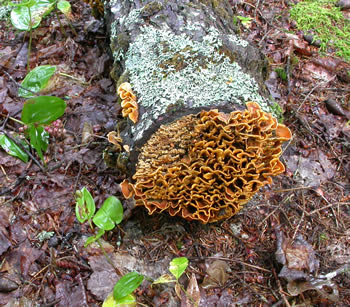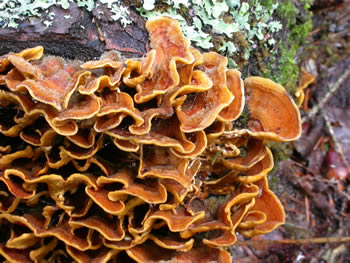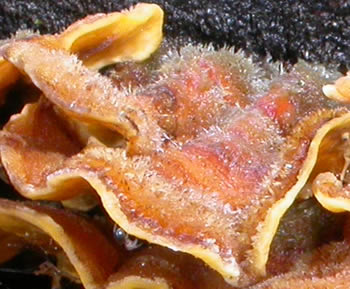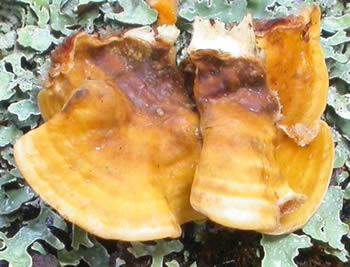Stereum hirsutum
Scientific name: Stereum hirsutum (Willd.) Pers.
Derivation of name: Ster- means "tough, firm, solid."
Hirsut- means "hairy" (hirsute) in reference to the hirsute
upper surface of this fungus.
Synonyms: Thelephora hirsuta Willd.
Common name(s): Hairy parchment.
Phylum: Basidiomycota
Order: Russulales
Family: Stereaceae
Occurrence on wood substrate: Saprobic; overlapping,
laterally fused clusters on dead conifers or hardwoods; July
through November, persistent.
Dimensions: Shelf-like caps are 0.5 to 2 cm wide and may be
fused.
Sterile upper surface: Zoned; whitish to pale cinnamon-
brown to grayish; surface densely covered with coarse, stiff
hairs.
Fertile lower surface:
Smooth; yellowish to reddish-tan or
wood-brown.
Edibility: Inedible.
Comments: There are a number of closely related Stereum
species. Some species "bleed" (e.g., S. gausapatum) a red
fluid when cut or
scratched, others do not. The variability
among these species is such that some mycologists group
Stereum hirsutum, Stereum complicatum, and even
Stereum gausapatum as varieties of a single species. The
web sites below explore some of the
confusion regarding
the
application of certain names to certain
Stereum species.
More information at MushroomExpert.com:
More information at TomVolkFungi.net:

Figure 1. This Stereum hirsutum was growing on a conifer
log in Maine. Photo © Gary Emberger.

Figure 2. A closer look at the specimen in Figure 1. This
specimen was photographed in the rain and is quite wet
giving it a water-logged look. Photo © Gary Emberger.

Figure 3. Note the zonation and the conspicuous coarse
hairs on the upper surface. Photo © Gary Emberger.

Figure 4. The appearance of the lower fertile surface.
There was no evidence of "bleeding" when this fungus was
torn away from the log. Photo © Gary Emberger.